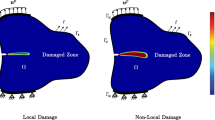Abstract
The discrete dislocation method is employed to determine the dislocation configurations associated with a continuous plastic crack subjected to both loading and unloading. The concept of anticrack dislocations is introduced in order to satisfy the free surface boundary conditions on the surfaces of the unloaded crack associated with lattice dislocations in its plastic zone. Various configurations of the unloaded crack, which incorporate a zipping action of the crack surfaces to reduce surface energy, are illustrated schematically wherein the discrete dislocation analysis is utilized. The results are obtained for both a tensile and a shear crack.
Résumé
On utilise la méthode de dislocations discrètes pour déterminer la configuration des dislocations associées à une fissure plastique continue soumise à une charge et à déchargement. Le concept de dislocation d'anti-fissure est introduit en vue de satisfaire les conditions aux limites de surface libre sur les faces de la fissure non chargée, associées aux dislocations des réseaux dans la zône plastique. Des configurations variées de fissures non soumises à sollicitation qui comportent une action de fermeture des surfaces de fissure en vue de réduire l'énergie de surface, sont schématiquement illustrées dès lors que l'analyse par dislocations discrètes peut être utilisée. Des résultats sont obtenus pour des fissurations sous tension et sous cisaillement.
Similar content being viewed by others
References
J.D. Eshelby,Philosophical Magazine, 40 (1949) 903
B.A. Bilby, A.H. Cottrell and K.H. Swinden,Proceedings of the Royal Society, London, 272A (1963) 304
M.J. Marcinkowski and E.S.P. Das,Physica Status Solidi, A8 (1971) 249
E.S.P. Das and M.J. Marcinkowski,Journal of Applied Physics, 43 (1972) 4425
M.J. Marcinkowski,Journal of Applied Physics, 46 (1975) 496
K. Jagannadham and M.J. Marcinkowski,International Journal of Fracture, 14 (1978) 155–171
K. Sadananda, K. Jagannadham and M.J. Marcinkowski,Physica Status Solidi, A44 (1977) 633
K. Jagannadham and M.J. Marcinkowski,Physica Status Solidi, A52 (1979) 663
K. Jagannadham and M.J. Marcinkowski,Physica Status Solidi, A42 (1977) 439
K. Jagannadham and M.J. Marcinkowski,International Journal of Fracture, 15 (1979) 119–133
K. Jagannadham and M.J. Marcinkowski,Materials Science Engineering, 38 (1979) 259
K. Jagannadham and M.J. Marcinkowski,Physica Status Solidi, A50 (1978) 293
M.J. Marcinkowski, In Advances in Materials Research, Ed. H. Hermann, John Wiley and Sons (1979)
Author information
Authors and Affiliations
Rights and permissions
About this article
Cite this article
Jagannadham, K., Marcinkowski, M.J. Discrete dislocation analysis of pre-existing cracks. Int J Fract 16, 193–206 (1980). https://doi.org/10.1007/BF00013377
Received:
Revised:
Issue Date:
DOI: https://doi.org/10.1007/BF00013377




